"Chinkuchi" and "Gamaku” The Physical Foundations of all Martial Science Training
Let me preface this narrative by stating this article is less intended to be instructive in nature but more designed to promote a deeper understanding of martial arts training in general and more specifically, martial science studies. While there is a good bit of information here, this is just the tip of the proverbial iceberg. Information like this was not taught to students of modern Karate. Plus we never thought to ask because we didn’t even know what to ask. We accepted anything and everything our instructors told and taught us as if it were the gospel. Why would we ever think to question?
At the beginnings of my martial science studies in the late 1980’s, a whole new world opened up. Even our instructors were new to this field, so it truly was a concerted learning effort between teacher and student alike, both equally open to scrutiny and proof. This is in all intents and purposes the very definition of scientific study and is why our system and methods blossomed and flourished… at least in the earlier stages. As time went on, the atmosphere began to steer away from the ideals of respectful mutual questioning and challenging ,and encouraging free thinking to one very similar to the ‘good ole’ days of “do as I say, without question”. It also seems that continued innovation and revision of training material may not always be conducive to financial profits.
With all this in mind, it is my sincere intent to provide an alternative thought to anyone’s current studies and provide encouragement to those already on the path of martial science studies to never accept for the sake of accepting, to respectfully question, and challenge each other with the sole purpose of unselfish progress…
When most hear the term ‘martial science’, they think of topics like pressure points, meridians, qi flow and other acupuncture and TCM (Traditional Chinese Medicine) associated sciences and practices. And while all of these studies and practices will definitely compliment a practitioner’s studies, the practitioner will have limited success in initiating an attack or response without the proper mechanical delivery system.
Let’s put this idea into perspective of say, your car. While the overall mechanical physics of a vehicle and its internal components, i.e. wheels, axels, drive chain, engine, electronic ignition, etc. are consistent between auto makers, one of the most deciding factors when purchasing a vehicle are its added features and technologies. Today’s cars come with all sorts of advances such as WIFI, GPS, keyless operations, wireless charging, hands free calling and messaging, lane departure warning systems, and an ever-growing list of other technologies and apps.
Aside from the cost factor, the choice on which model of car to buy is largely determined by the buyer’s wants more than needs. While not as attractive as the technological creature comforts, vehicle life span and fewer visits to a mechanic are great attractors. All in all, this is directly related to the various connected, yet distinctive technologies installed in a vehicle, each designed to work within its own framework but purposely designed to interactively function with the others. But when it comes down to it, without the foundational functioning of the car, all of these added technologies and accessories are moot.
The same applies to the study of martial science and those that teach it. Think of it as the difference between a car manufacturer and the dealership and sales staff. Dealerships and sales staff are common and vary greatly. Some dealerships have very well trained and knowledgeable sales staff and offer a wide range of support services while others have neither. The car manufacturer on the other hand is not just responsible to produce a quality product, they have advanced R&D and design teams with deep and extreme knowledge of each and every part involved in the vehicle’s construction as well as the many connected technologies of the vehicles the deliver. The car you drive today started in design years before it ever hit the showroom floor. In some ways, even the newest of vehicles are trailing current technologies
Unlike most everything in today’s modern world, the human body remains essentially the same as it has for hundreds of thousands of years. And while our technical understandings and abilities to apply our ever expanding knowledge grows, without a firm and deep level of the physical functioning of the human body would be akin to trying to install modern technologies into a vehicle without understanding if it can support the varied and interactive technologies.
This is the parallel similarity between martial science organizations and teachers. Some organizations and their instructors act more as dealerships, some offering a complete line of services whiles others just want to sell you a car. Then there are the organizations that align with the ideal of a manufacturer, where continued success relies on a thorough understanding of the foundational physics of any vehicle in conjunction with an ever-expanding world of integrated technologies.
In today’s world of martial science studies, modern sciences and technologies abound. What is greatly missing for most of today's sports based and franchised based martial arts is the need for a deeper examination and understanding of the human physiology and inherent “technologies”. Without this essential bedrock, every existing practice and application will become stangnant, crumble and fall.
As we evolve in our studies and trainings, there is this ongoing recycling of sorts. As our understanding grows, our practices and abilities transform, requiring a constant modification of our training practices. There is a constant disintegration and regeneration of what we know and do today, and that of tomorrow. In the 35+ years I have been practicing and teaching my art as a martial science, it has consistently evolved and transformed. I discover something new almost daily which impacts my personal practices and what I teach my students.
The greatest renaissance in my continued studies is the realization that 90% of the sciences specific to acupuncture and TCM have little real time application with martial life-protection practices. A person armed with a deep working knowledge of body mechanics and a superficial application of just a few TCM applications will easily overwhelm one with the reverse abilities.
There are two such physiological training applications in Okinawan martial science methods: "chinkuchi" and "gamaku". What exactly are "chinkuchi" and "gamaku"?
"Chinkuchi"チンクチ
Chinkuchi (Okinawan dialect) translates to "a single force" or "a small force". The etymology of the name is the large "power" that can be demonstrated in just "a little bit" of movement.
Chinkuchi refers to the discharge of explosive power and is not limited to any particular striking method or part of the body. Chinkuchi requires a concerted application of the entire muscle-skeletal system (muscles, bones, and related connective tissues and fascia). In the Chinese arts, this exacting idea is known as fa jin (發勁). One example of chinkuchi is the “one-inch punch”.
In Japanese martial arts, this is mistakenly likened to kime (決め). In Karate it can mean "focused power", describing the instantaneous tensing at the correct moment during a technique. The tension is mostly focused on the hara/tanden and abdomen. Based on these very superficial definitions chinkuchi and kime, which fare vey different by function and intent.
To achieve chinkuchi, all of the muscles, tendons, ligaments, breathing and mental intentions must be in perfect coordination in a single moment of time. It is not all that difficult to begin to understand chinkuchi. Motions like popping a towel or tossing a Frisbee, even sneezing are everyday examples of chinkuchi. With that being said, aligning all the necessary ingredients requires a lifetime of unselfish personality and devoted training. And while many of the trainings and methods may be the same among practitioners, understanding and developing chinkuchi is as personal and distinct as the expression of emotion between any two people.
In terms of physics, it is a ‘simple’ matter of physiological alignment, coordination, and torque. The body begins in a relaxed physical state, which is then quickly accelerated like a "whip" in a coordinated movement of the entire body. After impact, the strike immediately retracts and returns to a relaxed state. The shortened impact time increases the impulse of the strike (kinetic energy, or the energy of motion) and provides for a seamless technical flow. The functions of contract/release and raising/dropping combined with breath, describe four of the twelve types of kinetic energy: motion energy, elastic energy, gravitational energy and sound energy.
Chinkuchi involves the conscious activation of the interweaving connected muscle-skeletal postures, with the route of the power transmitted from the feet, passing through the chinkuchi, and passing from the shoulder to the fist, called "hanging the chinkuchi".
Two well-known exercises that will assist in learning the musculoskeletal connections needed to perform chinkuchi are the katas Sanchin and Tensho. “Sanchin testing”, or shime, is a sensory exercise (Proprioceptive Neuromuscular Facilitation or PNF), more so than a physical and mental toughening exercise. Like any proprioceptive exercise, it requires specific input (percussion and/or resistance) and dissemination of the output (feeling and adjustment by both the performer and the tester). This requires a partnership between the performer and the tester.
The percussive actions alert both parties to any limitations in the performer’s skeletal alignment and supporting musculature. Within the field of sport’s professions, this is referred to as Muscular Activation Techniques, or MAT®, a revolutionary approach to the assessment and correction of muscular imbalances, joint instability, and the limitations in range of motion within the human body.
"Gamaku" ガマ
Next is "Gamaku”. "Gamaku" is the Okinawan term that refers to the body’s center from where power is generated. In Japanese martial arts, this is known as koshi (腰) and kua (胯) in the Chinese arts. and involves the muscles around the side, back, abdomen and pelvis that connects the upper and lower body. While this seems to mirror the Japanese term “koshi” (waist, hips, hip, loins, lumbar), gamaku, like kua, implies actuation of balanced and interconnected contractions and relaxations, more than just a physiological designation.
And while gamaku refers to some of the same muscles that make up our “core” muscles, there is a huge distinction in why and how we train. “Core Training” focuses on developing both individual and muscles groups specific to the mid-section, using both static and resistance methods to assist in better health. Unlike standard core training, training the gamaku extends to other muscles and skeletal structures and more importanty, is application based. While holding a plank for 5-10 minutes or performing 100 leg lifts is impressive and requires great control, strength and discipline, neither has real-time application in a life-protection application. This is further supported with the sports medicine training principle of “The Law of Specificity”, which states to get better in any activity, you must precisely practice the skill that you wish to develop.
Now is a good time to re-enforce the purpose of the muscles in relation to chinkuchi and more importantly, gamaku. Muscles are responsible for three basic functions in the body. Muscles create movement, generate heat, and provide basic postural support. The most obvious function, movement, includes everything from the ability to walk to scratching your nose. So, while these topics focus largely on the muscles, the primary emphasis is always to understand and maximize proper skeletal alignment, or posturing … the very definition of the Law of Specificity.

This is particularly essential as there are two gamaku, right and left sides (circled in red), each relative to that leg and each responsible to open and/or close its own gamaku, while interactively coordinating with the other. You can compare this idea of this left and right opening and closing similar to how the valves of the heart open and close to pump blood throughout the body.
"Putting the gamaku" is to build up force with a subtle breathing (イキ)in the left or right gamaku. It can be said that the stability of the waist and the posture of the upper body are decided by the gamaku is put in (physical structure), and the operation of gamaku is a resulting technique.
"Putting the gamaku" and "use the gamaku" means to change the energy collected in the hara (the area just below the navel (下丹田 Lower Tan t’ian in Chinese), through the integration of the upper body and the lower body by sacrum operation.
This interactive relationship can further be demonstrated by rotating two balls in the palm in various patterns: a. Rolling the balls simultaneously and evenly, or b. Rolling one ball around the other (acts the center/hinge).


Imagine balloons filled with water positioned in the lower abdomen and pelvic cavity; left, right, and center of the waist. Because the water in the balloon has fluidity, when changing the center of gravity, by moving the water in the balloon, the body adjusts accordingly but this adjustment is not visible from the outside
If you hang the center of gravity, put the gamaku, on the right by moving the water in the balloon to the right, the right side of the waist is gravity-dropped, but this does not outwardly affect the outward expression.
Chinkuchi and gamaku are interactively connected. While each requires specific and deliberate training on its own, they are interconnected and dependent on the other, just as inhaling and exhaling are separate actions but cannot exist without the other. The templates of chinkuchi and gamaku provide a deeper insight into the naming of Goju-Ryu 法剛柔呑吐 Hou wa goju wo donto su, “The way of breathing is hard and soft”.
In addition to chinkuchi and gamaku, there are two other specific training concepts and applications that come into play when training and functioning chinkuchi and gamaku in real time application; mutumi and meotode.
Mutimi ( ムチミ) is the ability to attack or respond without tightening. When thrusting or kicking, for example, the muscles of the hands and feet are not connectively actioned, and the technique is set up by “swinging” the torso and pelvis (door) on the root or supporting foot (hinge).
Meotode (夫妻手) literally translates to “husband-wife hand” and is a cornerstone training concept and technical application in Okinawa Karate. This interactive relationship explicitly insists that each hand and action are of equal importance and can render a technique insufficient if one or the other does not cooperatively coexist.
Mutimi and Meotodeo are further supported by other attack/defense applications such as body shifting; tenshin (休捌き) and tai sabaki (体さばき) evasive repositioning of the body and body movement (forward and back and body rotation), and irimi (入り身) direct entry into an attack).
In combination, all this will help further develop and define the “Five Combative Postures” (Body Alignment, Distancing, Footwork, Timing and Targeting/Placement of technique) and are central in the application of “Body Mapping”.
Following are a select group of muscles on which to focus that are directly associated in the development of chinkuchi and gamaku. Each muscle must be developed individually, then defined and further trained relative to the others and the various connected technical applications. Once these are understood, the next level is to begin working downward, starting with the muscles of the thigh. This is the primary intent in training Sanchin and Tensho Kata in our dojo. At the most basic level, the practitioner will focus on identifying and isolating the specific muscles associated to each part of a technique, both moving (ballistic) and stationary (static) postures.
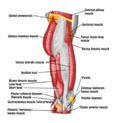
Latissimus Dorsi
The main work:
In motor movement, it is involved in operations such as stretching, and inner turning of the shoulder joint. It contributes to all the movements that can be attracted, such as judo, wrestling and Tuidi.
Training method:
Chinning (suspension), one-hand rowing (with tools), lat pull-down (machine), etc.

Serratus Anterior
The main work:
In the movement of motion, the shoulder joint has the effect of in turning, and extending the movement.
It contributes to the stroke movement of swimming along with the wide back and the movement like rowing the oar of the boat.
Training method:
Chinning (suspension), one-hand rowing (with tools), lat pull-down (machine) etc.
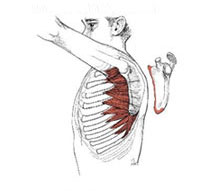
Teres Major
The main work:
In the movement of motion, there is an external turn of the shoulder joint, the action of horizontal outcrop.
It contributes to the operation of the backhand of tennis and the braking of the arm at the end of the pitching movement.
Training method:
External rotation (with tools)
Because the work of the small circle muscle is the external turn of the shoulder joint, the arm is turned out by tube training etc.
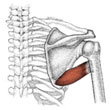
Teres Minor
The main work:
In the movement of motion, there is an external turn of the shoulder joint, the action of horizontal outcrop.
It contributes to the operation of the backhand of tennis and the braking of the arm at the end of the pitching movement.
Training method:
External rotation (with tools)
Because the work of the small circle muscle is the external turn of the shoulder joint, the arm is turned out by tube training etc.
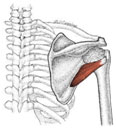
External Obliques
The main movement:
In motor movement, it is mainly involved in the turning, flexion, and side flexion of the body executive.
Training method:
Twisting Crunch, Dumbbell Twist, Side Crunch, trunk (Core) training, kicking, etc.

Abdominal Obliques
The main movement:
In motor movement, it is mainly involved in the turning, flexion, and side flexion of the body executive.
Training method:
Twisting Crunch, Dumbbell Twist, Side Crunch, trunk (Core) training, kicking, etc.

Transverse Abdominals
The main movement:
It has the effect of boosting intraperitoneal pressure and is involved in maintaining the stability of the lumbar spine. It also has the effect of lowering the lower ribs down.
Training method:
Draw-in, trunk (Core) training, kicking, etc.
Remarks:
It is a muscle that works to "pull the stomach". Abdominal muscles are not literally "next to the belly" muscles. It is a muscle located under the abdominal oblique muscles and on the innermost and visceral side of the abdominal muscles.

Muscles of the Thoracic Cavity relative to the Spine and Rib Cage
The main movement:
In the movement of the movement, there is an effect of extending the body executive (back bending), and side bending.
Training method:
Back extension (so-called dorsing motion)
If it is too warped in the training, the burden will be placed on the lumbar spine. Be careful not to deflect too much.
Remarks:
These muscles connect to the thoracolumbar spine, the thoracal ribs, and the lumbar ribs.
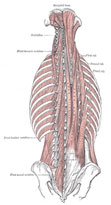
Psoas Major
The main movement:
In motor movement, it is involved in the flexion (front flexion) movement of the hip joint.
Training method:
Leg Raises, trunk (Core) training, stepping in stances, kicking, etc.

Lumbar Aurhogata
The main movement:
Lumbar muscles are not only side flexion, but also very important muscles related to posture retention.
Training method:
Pelvic walking, trunk (core) training, kicking, etc.

‹ Back
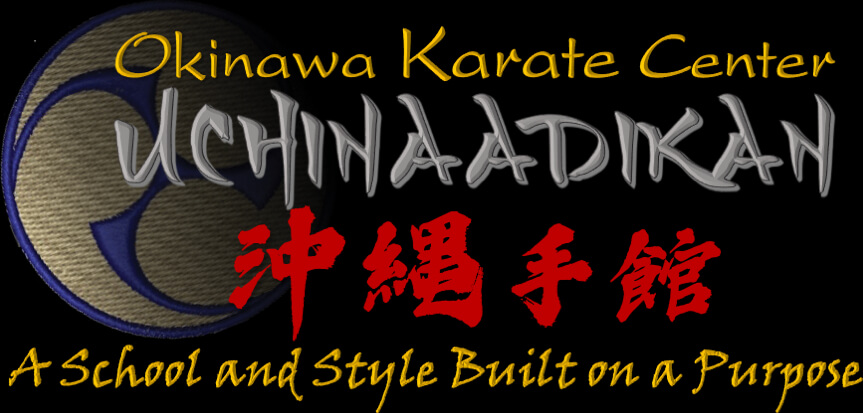



 ·
· 